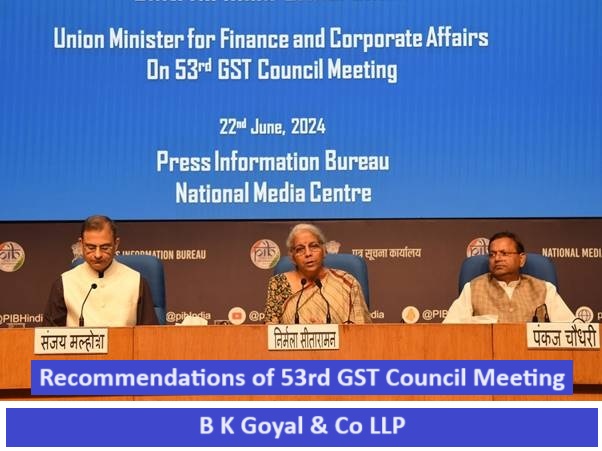Analysis of E-Commerce Operators in GST
The digital revolution has transformed traditional commerce, paving the way for e-commerce – a realm where businesses transcend physical boundaries. With the rise of e-commerce, suppliers can showcase their products or services on global platforms, reaching a massive audience. However, this digital transformation brings its unique set of challenges, especially in understanding and complying with tax regulations. This blog delves into the intricate provisions under GST legislation relevant to e-commerce operators (ECOs), Defining E-commerce and ECOs:E-commerce: Defined as the supply of goods or services, including digital products, over digital or electronic networks. E-commerce Operator (ECO): Any person who owns, operates, or manages a digital or electronic facility or platform for e-commerce. The definition encompasses not only platform owners but also those who manage or operate such platforms. The buying and sale of products and/or services via electronic means such as the internet is referred to as E-Commerce. E-Commerce refers to any type of online commercial transaction. Online shopping is the most common example of E-Commerce, which is defined as the purchasing and selling of items through the internet on any device. E-Commerce, on the other hand, can include a variety of activities such as online auctions, payment gateways, online tickets, and internet banking. Section 2(44) of the CGST Act 2017 defines e-commerce as “the delivery of goods or services or both, including digital items, through a digital or electronic network.” It is simply the purchasing or selling of things via the Internet, but it is also crucial to understand where an e-commerce operator does not have a physical presence in the taxable region. Payment of GST by E-Commerce Operator or E.C.O An E-Commerce transaction involves three parties: the provider, the customer, and the E-Commerce operator. There are two separate transactions for which GST requirements apply: Between the provider and the buyer for the provision of products or services and For the usage of the marketplace, a commission is payable between the provider and the E-Commerce operator. Both of these transactions are subject to GST on e-commerce operators. Certain specified transactions announced under Section 9(5) of the CGST Act 2017 and Section 5(5) of the IGST Act 2017 require the E-Commerce Operator to pay the GST on behalf of the suppliers: Sl. No. Description of Supply of Specified Service Supplier of service 1 Transportation of passengers by a radio taxi, motor cab, maxi cab, and motorcycle Any person (Individual, HUF, etc.) 2 Providing accommodation in hotels, inns, guest houses, clubs, campsites, or other commercial places meant for residential or lodging purposes Any person, except those who are liable to obtain registration under Section 22(1) of the CGST Act 3 House-keeping, such as plumbing, carpentering, etc Any person, except those who are liable to obtain registration under Section 22(1) of the CGST Act Applicability of Section 9(5) of CGST Act Basis Section 52 Section 9(5) Collection of TCS/Tax Liability TCS to be collected by the e-commerce operator on the net value of taxable supplies made by other suppliers through it. Liability of tax falls on the e-commerce operator and he is treated as if he is the supplier of those services. Registration Compulsory registration for both the e-commerce operator as well as the actual supplier Voluntary registration can be availed by the actual supplier. e-Commerce operator must mandatorily obtain registration. Threshold Exemption Not applicable. Applicable in the case of the actual supplier. Compliance Form GSTR-8 has to be filed every month (TCS collected as well as details regarding the supplies). Form 2A of each supplier will reflect the details entered in GSTR-8 by the e-commerce operator. Form GSTR-3B needs to be filed in this case, specifically Table 3.1.1. Reverse Charge Mechanism Not Applicable Applicable This section focuses on certain categories of services for which the tax is levied and paid by the e-commerce operator if the services were rendered through them. This includes- Passenger transport services Housekeeping services Restaurant services (includes cloud kitchens) Accommodation services Irrespective of whether the supplier is registered under GST, the e-commerce operators will be liable to pay tax as if it were the supplier per the reverse charge mechanism. The supplies under this section will be mainly intra-state supplies. Earlier, for restaurants and cloud kitchens providing services through e-commerce operators such as Zomato, Swiggy, etc., the restaurant was liable to pay the GST on its services. However, w.e.f. On January 1st, 2022, the e-commerce operators (Zomato and Swiggy) are liable to pay tax under the reverse charge mechanism. It has to be paid via the electronic cash ledger at a rate of 5% whether or not the restaurant (actual supplier) is registered under GST or not. Moreover, there can be no claim for Input Tax Credit in this case. The invoice for any of the services notified under Sec 9 (5) will be issued by the e-commerce operator themselves. Suppose, under one order, the e-commerce operator provides a combination of services under notified services [Sec 9 (5)]. In that case, a separate bill should be raised by the e-commerce operator for the component under notified services. Suppose the e-commerce operator has no physical presence in the taxable territory. In that case, the tax liability will fall on anyone representing the e-commerce operator for any purpose in that territory. However, suppose the e-commerce operator does not have a physical presence nor a representative in the taxable territory. In that case, the e-commerce operator will appoint the person liable to pay the tax. Compliance and return filing for e-commerce operators under Section 9(5) Section 9(5) are to be reported by the supplier and the e-commerce operator. This table will go live on 1st August 2022. For the e-commerce operator The supplies that attract Section 9 (5) shall be reported in Table 3.1.1 (i). The payment of tax has to be made by the e-commerce operator in cash. Payment via ITC is not permitted. Additionally, these supplies should not be included in Table 3.1. (a) of the GSTR-3B. For the supplier of services (registered person) The supplies that attract Section 9 (5) shall be reported
Analysis of E-Commerce Operators in GST Read More »

